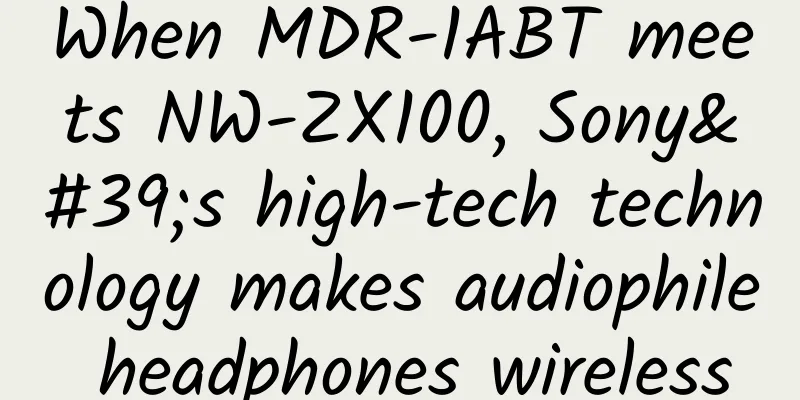When MDR-1ABT meets NW-ZX100, Sony's high-tech technology makes audiophile headphones wireless

|
When talking about Sony, we can’t avoid talking about black technology. After Hi-Res became Sony's golden signboard in the audio field, freeing audiophile-grade audio equipment from the constraints of wires has been the most hotly debated topic among Sony's "headphone party" in recent years. When it comes to how to achieve this wireless audiophile quality, the combination of Sony's MDR-1ABT headphones and NW-ZX100 player is undoubtedly an ideal device. What did you buy for more than 5,000 yuan? According to the official retail prices of Sony MDR-1ABT headphones and NW-ZX100 player, which are 1,999 yuan and 3,499 yuan respectively, the total cost of more than 5,000 yuan to purchase a set of pure audio playback is undoubtedly something that ordinary users who use iPhone and EarPods to listen to music cannot understand. Sony MDR-1ABT is another extended product in Sony's MDR-1A series of high-resolution sound quality headphones. The appearance style is not much different from the other MDR-1A headphones. The BT in the name stands for BLUETOOTH Bluetooth connection. The specification is Bluetooth 3.0, and the uninterrupted playback time is about 30 hours. In terms of parameters, the Sony MDR-1ABT uses a 40 mm driver unit, a frequency response of 4 Hz - 100000 Hz, a maximum input power of 100 mW, an impedance of 24 Ω, and a sensitivity of 98 dB/mW, which is similar to other versions of the MDR-1A. However, it is worth noting that as a headset with wireless functions as its main feature, these parameters are reflected in the usage conditions marked as "when using a headphone cable" on Sony's official website. Compared to headphones, Sony's NW-ZX100 player has the familiar Walkman flavor. It no longer uses the Android system like the previous NW-ZX2. The NW-ZX100 has a more pure appearance. The lightweight body of 145g uses a high-hardness aluminum frame, showing Sony's usual fine craftsmanship. Sony NW-ZX100 is equipped with a 3.0-inch WQVGA display. The screen effect is not as good as those smart audio and video players of the brand. In terms of sound quality, it supports S-Master HX digital amplifier technology, digital noise reduction and DSEE HX digital enhancement technology. The internal storage is equipped with 128GB capacity for large-capacity audio files and supports Micro SD card expansion. And like the MDR-1ABT headphones, the NW-ZX100 wireless connection is also based on Bluetooth 3.0. Can LDAC really save the poor Bluetooth sound quality? That's right, the Sony MDR-1ABT headphones are paired with the NW-ZX100 player. The way to listen to music wirelessly is still through the Bluetooth, which is not very high-tech, but Sony itself has brought the very high-tech LDAC high-quality wireless music listening technology, which looks quite interesting. For electronic products, there are three main Bluetooth audio encoding forms: aptX, SBC, and AAC. Compared with the current aptX with the highest data transmission speed of 352kbps, Sony's newly added LDAC can choose three bit rates: 990kbps (sound quality first), 660kbps (standard), and 330kbps (connection first). The data completely crushes aptX, which is said to be able to transmit lossless CD quality. From the fact that Sony's player products still promote LDAC technology on the basis of supporting aptX, we can also see Sony's great confidence in the new technology. In terms of actual listening performance, the maximum transmission speed of 990kbps gives LDAC technology a huge space for transmitting high-quality audio content via Bluetooth. The sound quality is definitely improved compared to ordinary Bluetooth headphones, but the subjective feeling is still not as good as the wired MDR-1A. There may be some psychological factors involved. On the other hand, how much has Sony's LDAC technology improved compared to aptX? This is another question about whether you are "agnostic", because when aptX became Qualcomm's technology, more and more smartphones have higher and higher wireless transmission capabilities for high-quality music. Whether you can hear the improvement brought by LDAC is even more of a test for your ears. It is worth mentioning that although the necessary condition for the implementation of LDAC technology is that both the player and the headphones support this technology, and currently only Sony's own products can meet this standard, the speculation and analysis conducted by some foreign websites that LADC technology can transmit high-bitrate Hi-RES files via Bluetooth is enough to make audiophiles' eyes light up. Its working principle is roughly a process of lossless compression, Bluetooth transmission, and then lossless decompression, achieving a compression ratio of nearly 4.5:1. Perhaps this also explains why in the introduction on Sony's official website, the battery life of the NW-ZX100 player in LDAC Bluetooth mode has been reduced from 45 hours in ordinary SBS mode to 28 hours. In addition to the sound quality issues that audiophiles are interested in, the combination of Sony MDR-1ABT headphones and NW-ZX100 player also brings a more technological way of using wireless audio devices, such as NFC touch connection and touch operation on the side panel of the headphones. Of course, this is nothing surprising on Sony products. Wireless high-quality sound? At least worth a try In some respects, products like Sony's MDR-1ABT headphones and NW-ZX100 player have made some new attempts based on traditional audio equipment. What is more interesting is that Sony's new Xperia smartphone is also covered by LDAC technology. This shows Sony's determination to promote LDAC technology. In essence, whether it is the MDR-1ABT headphones or the NW-ZX100 player, these audio products that support LDAC technology have never excluded the traditional connection form through wires. Even with the help of wires, the MDR-1ABT can be transformed into a standard MDR-1A headphone. Therefore, Sony itself may not really think that with the help of LDAC technology, it can change the inherent "wired" plot of audio enthusiasts. On the contrary, Sony has brought another new way of experiencing high-quality audio to audio enthusiasts, which eventually became a new wireless transmission technology. This attempt is at least worthy of recognition. As a winner of Toutiao's Qingyun Plan and Baijiahao's Bai+ Plan, the 2019 Baidu Digital Author of the Year, the Baijiahao's Most Popular Author in the Technology Field, the 2019 Sogou Technology and Culture Author, and the 2021 Baijiahao Quarterly Influential Creator, he has won many awards, including the 2013 Sohu Best Industry Media Person, the 2015 China New Media Entrepreneurship Competition Beijing Third Place, the 2015 Guangmang Experience Award, the 2015 China New Media Entrepreneurship Competition Finals Third Place, and the 2018 Baidu Dynamic Annual Powerful Celebrity. |
>>: Is it reliable to use mobile phone software to repel mosquitoes?
Recommend
It’s not that it’s harder to get traffic, it’s that you don’t understand your users!
What do users like to pay attention to? How can w...
Technical analysis: Can a kitchen knife be used to smash garlic?
Some time ago, the news that a well-known kitchen...
Xigua Video’s Millionaire Heroes: Presenting a powerful way to attract new users to the App?
In the past week, games that require answering qu...
The fruits in supermarkets are generally good-looking! Is it because they have been added with something "active"?
When you visit the fruit section of a supermarket...
Isn’t it really a waste of money to spend so much money on protecting wildlife?
Protecting wildlife can help the Earth have a hig...
Apple asks iPhone price cut: domestic production capacity will be transferred to India
Beijing time, December 30th news, there have been...
"Forkiss Pregnancy Yoga" for a healthy baby and a beautiful mother Baidu Cloud Download
《Forkiss Pregnancy and Childbirth Yoga》 For a hea...
Does the APP record your voice?
1 There have been a lot of big promotions recentl...
The temperatures measured by several thermometers are different. Do I have a fever?
Winter and spring are the peak seasons for influe...
Why does your heart skip a beat when you stay up late?
Have you ever been frightened by a sudden "s...
You may not have thought of it: five ways to reduce the cost of acquiring users!
In the mobile gaming industry, user acquisition is...
Squirrels can't speak bird language, so how come they are so interested in listening to the birds chatting next door?
Nature is not a very friendly place for small ani...
eMarketer: Two-thirds of global executives say security is the biggest obstacle to the development of the Internet of Things
199IT original compilation As the Internet of Thi...
After working on information flow for half a year, I found these 3 points to be super useful!
When it comes to information flow , I think most ...
Spiders play mahjong? This little spider throws a four-piece card at you!
What is March 14th? White Day? Pi Day? Not only t...









